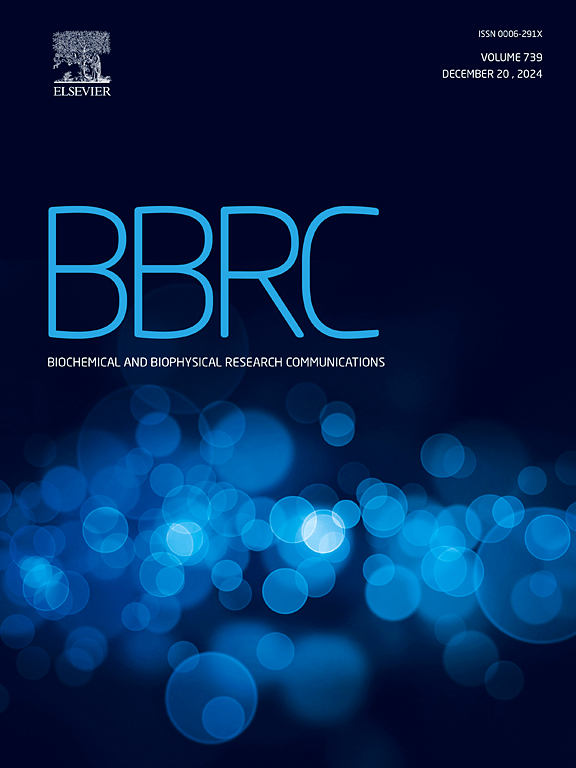DEAD-box解旋酶DDX3X解旋RNA双链机制的揭示:对原蛋白协同作用和作用的见解
IF 2.5
3区 生物学
Q3 BIOCHEMISTRY & MOLECULAR BIOLOGY
Biochemical and biophysical research communications
Pub Date : 2025-06-13
DOI:10.1016/j.bbrc.2025.152206
引用次数: 0
摘要
DDX3X是一种人类DEAD-box解旋酶,参与atp依赖的短RNA双链解绕,在RNA代谢、癌症进展和HIV-1感染中起关键作用。它由一个N端区域(N:残基1-131),一个包含两个reca样结构域的解旋酶核心(D1D2:残基132-607)和一个C端尾部(C:残基608-662)组成。先前的研究表明,D1D2与dsRNA形成预解绕复合物,在rna解绕和atp酶活性方面都表现出两分子的协同性。然而,全长DDX3X (N-D1D2-C)解绕RNA的合作机制仍有待充分了解。由于知道c端尾部对寡聚化至关重要,我们创建了一个n -截断形式的DDX3X (D1D2-C:残基132-662)以供进一步研究。我们的研究结果表明,D1D2-C在RNA底物存在下寡聚,对RNA解绕活性表现出三分子协同性,对atp酶活性表现出两分子协同性。此外,D1残基E186和c端尾对于D1D2-C的寡聚化至关重要,从而形成两种类型的亚基界面,一种是在两个D1结构域之间(C-D2D1:D1D2-C),另一种是在两个c端尾之间(D1D2-C:C-D2D1)。这些结果为研究DDX3X协同解绕RNA的分子机制提供了新的思路。本文章由计算机程序翻译,如有差异,请以英文原文为准。

Unraveling the mechanism of RNA duplex unwinding by DEAD-box helicase DDX3X: Insights into Cooperativity and roles of protomers
DDX3X, a human DEAD-box helicase involved in ATP-dependent unwinding of short RNA duplexes, plays a pivotal role in RNA metabolism, cancer progression, and HIV-1 infection. It is composed of an N-terminal region (N: residues 1–131), a helicase core containing two RecA-like domains (D1D2: residues 132–607), and a C-terminal tail (C: residues 608–662). Previous research has shown that D1D2 forms a pre-unwound complex with dsRNA, exhibiting two-molecule cooperativity for both RNA-unwinding and ATPase activities. However, the cooperative mechanism by which the full-length DDX3X (N-D1D2-C) unwinds RNA remains to be fully understood. Knowing that the C-terminal tail is crucial for oligomerization, we have created an N-truncated form of DDX3X (D1D2-C: residues 132–662) for further investigation. Our findings indicate that D1D2-C oligomerizes in the presence of RNA substrate, exhibits three-molecule cooperativity for RNA-unwinding activity, and displays two-molecule cooperativity for ATPase activity. Furthermore, D1 residue E186 and C-terminal tail are essential for the oligomerization of D1D2-C, enabling two types of subunit interface to form, one between two D1 domains (C-D2D1:D1D2-C) and the other between two C-terminal tails (D1D2-C:C-D2D1). These results offer new insights into the molecular mechanism of cooperative RNA unwinding by DDX3X.
求助全文
通过发布文献求助,成功后即可免费获取论文全文。
去求助
来源期刊
CiteScore
6.10
自引率
0.00%
发文量
1400
审稿时长
14 days
期刊介绍:
Biochemical and Biophysical Research Communications is the premier international journal devoted to the very rapid dissemination of timely and significant experimental results in diverse fields of biological research. The development of the "Breakthroughs and Views" section brings the minireview format to the journal, and issues often contain collections of special interest manuscripts. BBRC is published weekly (52 issues/year).Research Areas now include: Biochemistry; biophysics; cell biology; developmental biology; immunology
; molecular biology; neurobiology; plant biology and proteomics

 求助内容:
求助内容: 应助结果提醒方式:
应助结果提醒方式:


